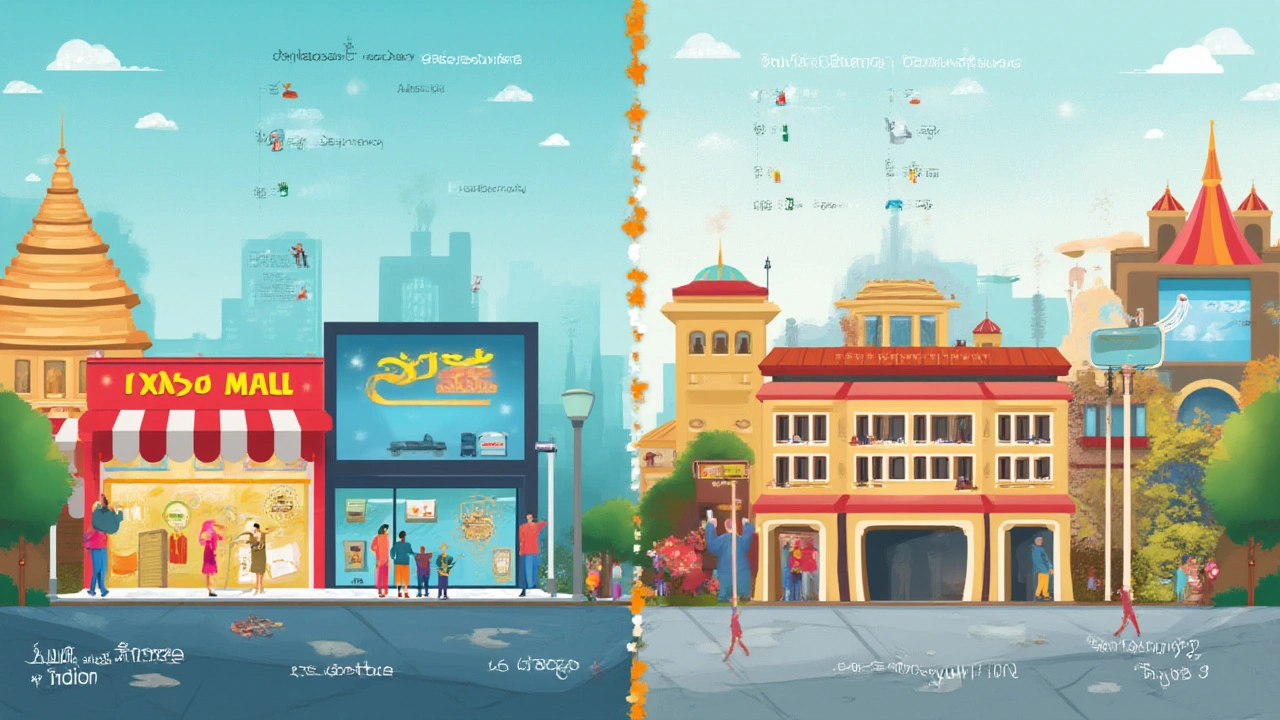Commercial vs Non-Residential Properties: Key Differences & Real Estate Insights

Picture this: you pass a gleaming office tower, a big-box retail store, a school, and a community hospital—all in the same neighborhood. On paper, they're all “non-residential,” but would you call the school or hospital “commercial”? Here’s where most people get tripped up. The words get thrown around like they’re twins, but they’re more like cousins who see each other at family reunions. If you’re thinking of diving into real estate, or just want to sound smart at parties, it's time to unpack what actually separates commercial and non-residential properties, and why knowing the difference makes a world of difference in everything from investment to zoning regulations.
What Does 'Commercial' Really Mean?
The word “commercial” pops up everywhere, but in real estate, it’s not a free-for-all. At its core, commercial refers to property developed and used mainly to make money. That means a building where people buy and sell things, rent offices to run businesses, or lease space for services (think restaurants, gyms, grocery stores). So, if your aunt owns a strip mall with ten shops, she’s in commercial property. If your uncle’s office downtown is home to five startups and a law firm, that’s commercial too. But here’s where it gets sticky. The term doesn’t cover every non-home building.
Let’s be clear: "commercial" does not mean anything that’s not a house or apartment. People often lump every non-residential property under “commercial,” but in industry talk, the lines are sharper. Hotels? Usually commercial, because they bring in money. Schools and churches? Usually not, unless you’re looking at a for-profit private school or event center. This isn’t just splitting hairs—banks and insurance companies treat these categories differently, and so do city zoning boards. In fact, the International Property Measurement Standards Coalition spells out specific use cases for commercial spaces, and separates out institutional, public, and mixed-use categories for clarity.
What about multi-family apartments? It depends on location. In the U.S., an apartment building with five or more units often slides into “commercial” because it’s an income property, but single-family rentals and duplexes are seen as residential, even though they might make someone a tidy profit. Go figure. Consider this: the Federal Reserve’s 2023 Commercial/Multifamily Survey found that 60% of large lenders apply stricter underwriting to properties classified as commercial versus other non-residential types. So, knowing your category impacts your financing, your taxes, and even the required inspections.
What Counts as Non-Residential Real Estate?
This is where it gets broader. Non-residential covers any building or parcel of land not primarily used as someone’s home. That means all commercial real estate is non-residential, but not all non-residential property is commercial. Confused yet? Don’t worry; the distinction is about use. Let’s dig deeper.
On the non-residential list, you’ve got things like public schools, government offices, hospitals, museums, police stations, and places of worship. These places might not make a profit, but they’re vital parts of any community. They sit alongside factories, warehouses, and even vacant land zoned for future business use. Each has its own permitting, building codes, and allowable uses, which can make a world of difference if you’re running searches on a listing site or calling city hall about possible tenants.
Take industrial properties for example: a warehouse stuffed with goods is non-residential, but it’s commercial if it brings in profit through leases or logistics operations. Hospitals are typically non-residential, but if a group runs a private surgical center as a business, now you’re flirting with the commercial side. Mixed-use properties really throw a wrench into the works—a building with retail on the first floor and apartments above often straddles both worlds. According to a 2024 report by the National Association of Realtors, mixed-use properties are the fastest growing segment, making up 14% of non-residential transactions that year.
| Property Type | Commercial? | Non-Residential? |
|---|---|---|
| Shopping Mall | Yes | Yes |
| Elementary School | No | Yes |
| Self-Storage Facility | Yes | Yes |
| Fire Station | No | Yes |
| Manufacturing Plant | Yes | Yes |
| Hospital (Public) | No | Yes |
| Fitness Center Franchise | Yes | Yes |
| Community Theater (Non-Profit) | No | Yes |
| Corporate Office Park | Yes | Yes |
| Municipal Library | No | Yes |
This table helps untangle it—commercial is a subset of non-residential, but you’ll see government, charity, and public service buildings sprinkled throughout the broader non-residential category like little islands.

Why the Distinction Matters: Zoning, Loans, and Taxes
Okay, now you might wonder: does it really matter what label you slap on a building? Isn’t real estate just real estate? Not quite. Classification affects almost everything – zoning, lending, taxation, how you insure your building, and even the energy codes you have to stick to.
Zoning is where the government flexes its muscle. Cities break up land into zones, dictating what you can build and where. If you want to open a craft brewery, you can’t just snag any empty lot—you need a property zoned for commercial or mixed-use, not something intended for a school or park. Try running a retail yoga studio in a spot zoned for industrial use, and you’ll run into trouble fast. Local zoning codes can be crazy specific—a city might have separate subcategories for “retail commercial,” “office commercial,” “general commercial,” and then a whole suite of “institutional” or “public use” designations. It pays to double-check before buying or renting.
Banks aren’t blind to these labels either. Apply for a loan on a commercial property and you’ll face different requirements and interest rates than you would for something like a church or non-profit center. Data from Freddie Mac’s 2023 lending report shows that commercial properties had about 1.1% higher annual rates than non-profit or government non-residential assets, mostly tied to their business risk. Some lenders won’t even touch institutional buildings, given the specialized use and low resale demand.
Don’t even get me started on taxes. Commercial properties often carry higher property tax rates because city financers see them as profit machines, while public buildings or religious centers may get hefty exemptions. In New York City, for example, commercial property can be taxed at rates more than double those for owner-occupied homes—and none for city schools or police stations. It’s all about who’s using the space and for what purpose. So if you’re hoping to invest, develop, or just manage a non-residential property, you’ll want to look long and hard at how it’s categorized in the city assessor’s office.
Common Misunderstandings and Insider Tips
Almost everyone starts by assuming “commercial” and “non-residential” are synonyms, so don’t feel embarrassed if you’ve mixed them up before. Landlords and realtors sometimes blur the lines in listings to drum up business or make things simple, but smart investors always read the fine print. Pay special attention to how a property is used right now—not just what it could be in the future. Insurance policies, for example, may only cover a property for its current use. If your church becomes a music venue, you’ll need a new policy.
Another common pitfall: getting excited about repurposing a neat old warehouse or a school building, only to discover massive regulatory hurdles because the zoning or use category is locked down tight. If you’re eyeing a cool historic firehouse, check city records first to see if it’s allowed to become a restaurant or boutique hotel. Local governments love their paperwork, and you don’t want to be two months into renovations before you hear the word "variance."
If you’re a buyer or investor, one of the best tips is to talk to both a commercial broker and a land-use attorney. The broker knows the market realities, but the attorney can help you dodge the red tape and spot hidden restrictions buried in the title deed. And if a deal seems incredible, ask yourself why—it’s often tied to the property’s classification. Next time you search online, look for search filters using both terms together (commercial and non-residential) so you don’t miss anything juicy.
Here's a fun real-life tidbit: In 2024, a group of tech developers in Chicago bought a vacant grammar school. They assumed since it wasn’t residential, they could fast-track conversion to coworking offices. City zoning law said no commercial activity on the block, so they had to pivot and build a community arts center instead—still non-residential, but not quite the cash cow they hoped for. Lesson learned: always double-check how a property is officially defined. This small detail can make or break your next big project.
Write a comment